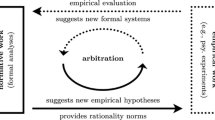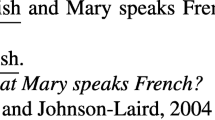Abstract
This study is concerned with the conjunction error as reported by Kahneman and Tversky (1982). In the prototypical problem that manifests this error, theLinda problem, subjects are presented with a description of a 31-year-old liberal progressive named Linda and asked to rank in order a number of events concerning Linda today in terms of their likelihood. The three events of interest areLinda is a bank teller (eventA),Linda is active in the feminist movement (eventB), andLinda is a bank teller and active in the feminist movement (eventA and B). Subjects typically rankedLinda is a bank teller and active in the feminist movement (A and B) higher thanLinda is a bank teller (A). This judgment violates a fundamental law of probability, namely, thatp (A and B) ≤ p(A). Kahneman and Tversky argue that this response tendency is a result of therepresentativeness heuristic which causes subjects to ignore logical considerations of set relations and to rank the choices in terms of their resemblance to Linda's description. On the other hand, we argue that the task demands compel subjects to interpret the choiceA asA and not-B. When subjects make the unusual comparison betweenA and its subclassA and B in the context of a description of Linda that is largely irrelevant to the task's solution,Linda is a bank teller becomesLinda is a bank teller and is not active in the feminist movement. With this interpretation, subjects' typical response patterns no longer can be considered in contradiction to logical principles. One experiment is presented that uses three French languageLinda-type problems in two conditions: one in which the expected implicature is blocked and one in which the implicature is encouraged to reappear. These are both compared to a French version of theLinda problem. The structure of theLinda problem is discussed in light of conversational principles, particularly relevance (Sperber and Wilson, 1986) and the maxim of quantity (Grice, 1975).
Similar content being viewed by others
References
Agnoli, F., & Krantz, D. H. (1989). Suppressing natural heuristics by formal instruction: The case of the conjunction fallacy.Cognitive Psychology, 21, 515–550.
Fiedler, K. (1988). The dependence of the conjunction fallacy on subtle linguistic factors.Psychological Research, 50, 123–129.
Grice, H. P. (1975). Logic and conversation. In P. Cole, & J. L. Morgan (Eds.),Syntax and Semantics (Vol. 3) New York: Academic Press.
Inhelder, B., & Piaget, J. (1964).The early growth of logic in the child: Classification and seriation. New York: Norton.
Kahneman, D., & Tversky, A. (1982). On the study of statistical intuitions.Cognition, 11, 123–141.
Kasher, A. (1976). Conversational maxims and rationality. In A. Kasher (Ed.),Language in focus: Foundations, methods and systems. Dordrecht, Holland: Reidel.
Leach, C. (1979).Introduction to statistics: A non-parametric approach for the social sciences. New York: Wiley.
Leddo, J., Abelson, R. P., & Gross, P. H. (1984). Conjunctive explanations: When two reasons are better than one.Journal of Personality and Social Psychology, 47, 933–943.
Locksley, A., & Stangor, C. (1984). Why versus how often: Causal reasoning and the incidence of judgmental bias.Journal of Experimental Social Psychology, 20, 470–483.
McGarrigle, J., Grieve, R., & Hughes, M. (1978). Interpreting inclusion: A contribution to the study of the child's cognitive and linguistic development.Journal of Experimental Child Psychology, 26, 528–550.
Morier, D. M., & Borgida, E. (1984). The conjunction fallacy: A task specific phenomenon?Personality and Social Psychology Bulletin, 10, 243–252.
Politzer, G. (1986). Laws of language use and formal logic.Journal of Psycholinguistic Research, 15, 47–92.
Politzer, G. (1989).Class-inclusion questions and conversational rules. Paper presented to the Franco-British Research Group on Philosophy and Cognitive Science. June 1989, Birkbeck College, London.
Shipley, E. F. (1979). The class inclusion task: Question form and distributive comparison.Journal of Psycholinguistic Research, 8, 301–331.
Sperber, D., & Wilson, D. (1986).Relevance: Communication and cognition. London: Blackwell.
Tversky, A., & Kahneman, D. (1982). Judgments of and by representativeness. In D. Kahneman, P. Slovic, & A. Tversky (eds.),Judgments under uncertainty: Heuristics and biases. Cambridge, England: Cambridge University Press.
Tversky, A., & Kahneman, D. (1983). Extensional versus intuitive reasoning: The conjunction fallacy in probability judgment.Psychological Review, 90, 293–315.
Wells, G. L. (1985). The conjunction error and the representativeness heuristic.Social Cognition, 3, 266–279.
Yates, J. F., & Carlson, B. W. (1986). Conjunction errors: Evidence for multiple judgment procedures, including “signed summation.”Organizational Behavior and Human Decision Processes, 37, 230–253.
Author information
Authors and Affiliations
Rights and permissions
About this article
Cite this article
Politzer, G., Noveck, I.A. Are conjunction rule violations the result of conversational rule violations?. J Psycholinguist Res 20, 83–103 (1991). https://doi.org/10.1007/BF01067877
Accepted:
Issue Date:
DOI: https://doi.org/10.1007/BF01067877




